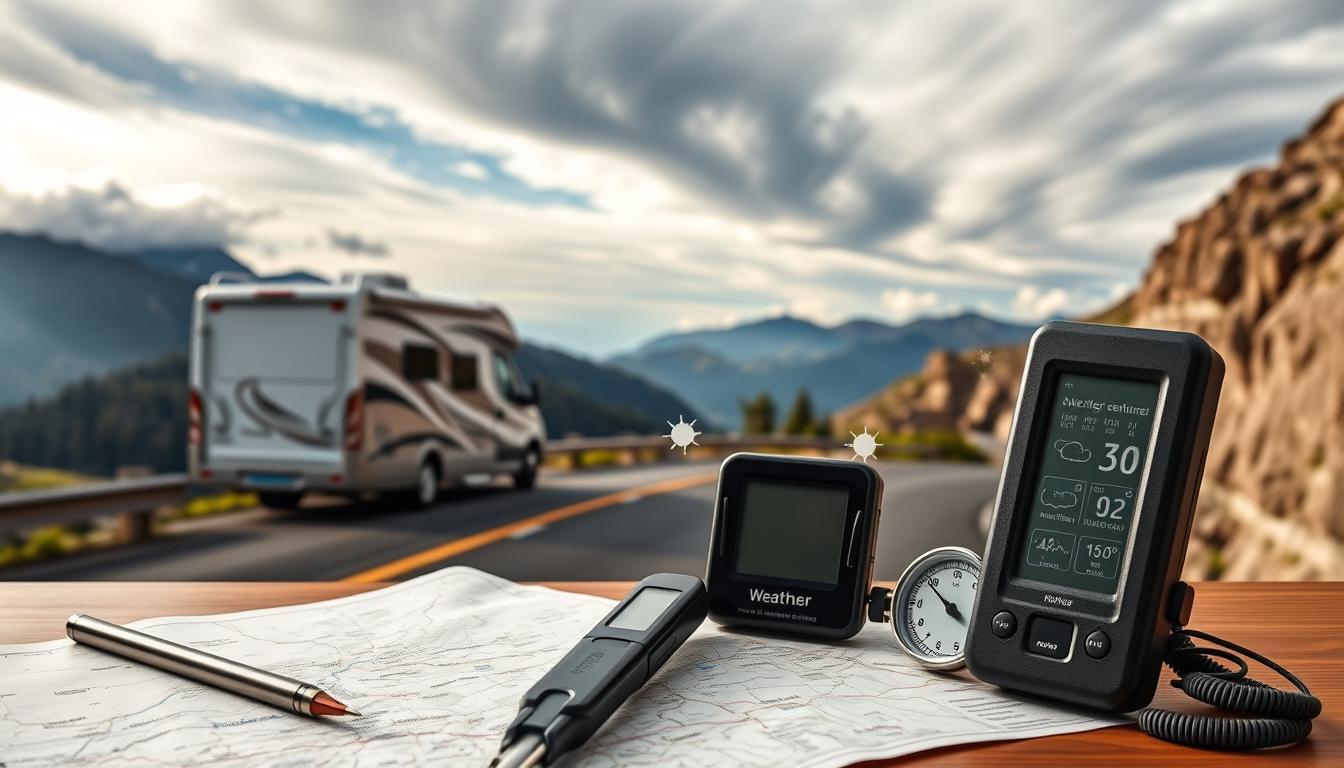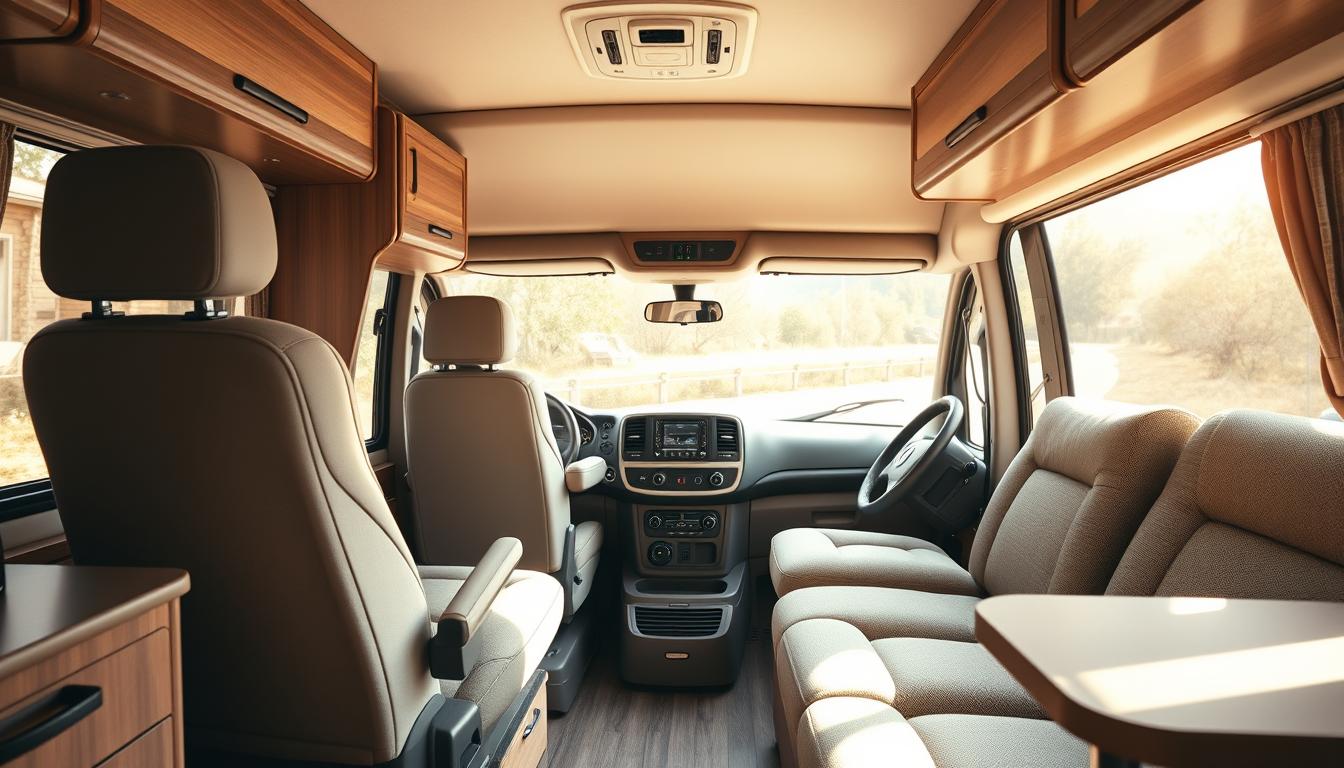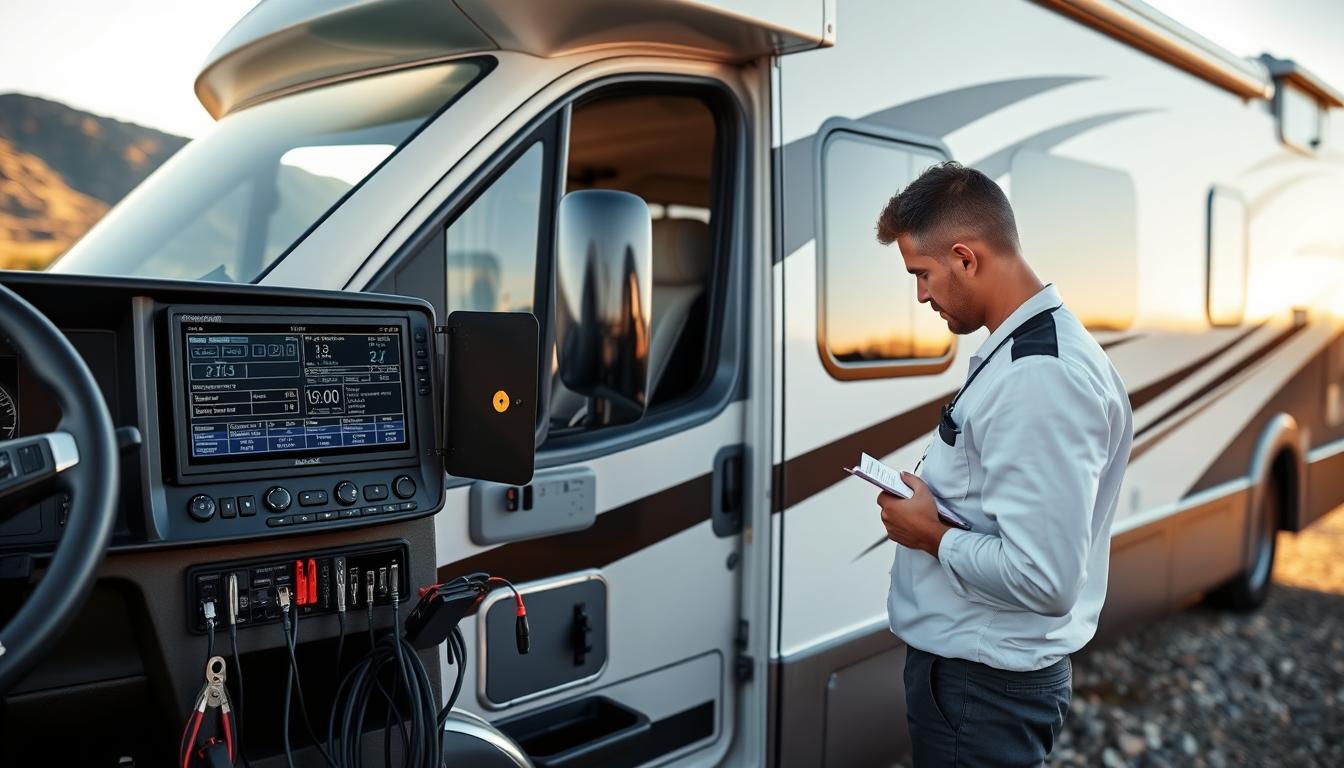Ever thought a small tool could prevent a big breakdown on your Class C motorhome? Remote fault diagnostic tools are changing RV diagnostics. But, they also come with hidden challenges. These tools help find problems early, giving you key insights into your motorhome’s health.
With Class C motorhomes getting more complex, knowing the risks of these tools is key. This guide will help you understand remote diagnostics better. It shows how to use them for easy RV maintenance.
Understanding Remote Diagnostic Tools
Remote diagnostic tools are key for RV owners. They offer many features to help diagnose problems. These tools can be physical scanners or apps on phones and computers. They connect to the RV’s systems, making it easy to check on the vehicle.
These tools use well-known diagnostic methods like OBD-II. They let users check the engine, battery, and more. This helps spot issues early, preventing bigger problems.
One of the best things about these tools is remote monitoring. It lets RV owners check their vehicle’s health anytime. This helps them plan maintenance and repairs, making travel safer and more reliable.
Importance of Diagnostics in Class C Motorhomes
Diagnostics are key in Class C motorhomes. They help find problems early, making RV care better. This way, owners can avoid big issues on trips, keeping the journey smooth.
Regular checks find hidden issues like electrical problems, leaks, and battery failures. Without these checks, these problems can cause big delays and expensive fixes. By making diagnostics a part of regular care, owners keep their motorhomes running well and last longer.
Putting effort into diagnostics means safer travels. It’s a smart move for motorhome lovers. It shows how important it is to check things out to keep everyone safe and happy.
Benefits of Using Remote Fault Diagnostic Tools for Class C Motorhome
Remote fault diagnostic tools offer big benefits for Class C motorhome owners. They let users keep an eye on their RV’s systems in real-time. This means they can watch things like battery health and engine performance closely.
They get alerts if something looks off, so they can fix it before it gets worse. This way, they can keep their RV running smoothly and reliably.
Real-time Monitoring
Real-time monitoring lets owners see how their motorhome is doing. They get alerts right away if the engine gets too hot or the battery runs low. This helps them stay on top of maintenance and avoid big problems.
This constant stream of info helps keep everything running well. It’s a big part of the diagnostic benefits.
Immediate Data Access
Having immediate data access means owners can act fast when they get alerts. They can quickly see what’s wrong and fix it fast. This makes fixing problems a lot easier and faster.
For more tips, check out the best tools for Class C motorhome mechanics here.
Common Issues Faced by Class C Motorhomes
Class C motorhomes are known for their comfort and convenience. Yet, they face several issues that can affect their reliability. These include electrical system failures, engine problems, and battery issues. Knowing about these problems helps owners with maintenance and quick fixes.
Electrical System Failures
Electrical system failures often show up as dim lights or broken appliances. These problems usually come from bad wiring or not enough power from converters. Without quick fixes, these issues can get worse, ruining travel plans.
Engine Problems
Engine troubles in Class C motorhomes can be many things. They might include overheating, strange noises, or less power. Keeping up with regular maintenance is key to spotting these issues early. This way, you can avoid expensive repairs and keep your travels smooth.
Battery and Converter Issues
Battery problems in RVs can be anything from not charging to bad connections with converters. Regular checks on battery and converter health can help avoid these issues. Good battery care not only makes your RV work better but also makes it last longer.
Choosing the Right Remote Diagnostic Tool
Choosing the right remote diagnostic tool is key for keeping Class C motorhomes in top shape. RV owners need to look at specific features that make a tool easy to use and effective. Different tools have different abilities, so knowing what to look for is crucial.
Key Features to Look For
When picking a remote diagnostic tool, consider these important features:
- Compatibility with many RV brands and models is vital for wide use.
- A user-friendly interface makes the tool easier to use, especially for tech novices.
- The power to do bi-directional testing gives deeper insights into system problems.
- Features for managing data, like cloud storage for historical data, help track maintenance history.
Brand Comparisons
Different brands offer unique features and prices. For example, JPRO is known for its wide RV brand compatibility, making it a favorite among RV fans. Other brands like BlueDriver and Launch might shine in areas like user experience or extra features. RV brands analysis helps choose tools that fit your maintenance needs and vehicle types.
Setting Up Your Remote Diagnostic Tool
Setting up diagnostic tools is key for top performance in Class C motorhomes. Start by connecting the tool to the OBD-II port, found under the dashboard. Then, install software on your computer or mobile to talk to the tool.
Knowing how to set up your device is important. Many tools come with manuals or online guides. These guides walk you through connecting and understanding the first diagnostic results.
Here are the basic steps for setting up:
- Find the OBD-II port in your motorhome.
- Plug in the diagnostic tool securely.
- Put the needed software on your device.
- Follow the setup prompts.
- Use the manual to understand the data.
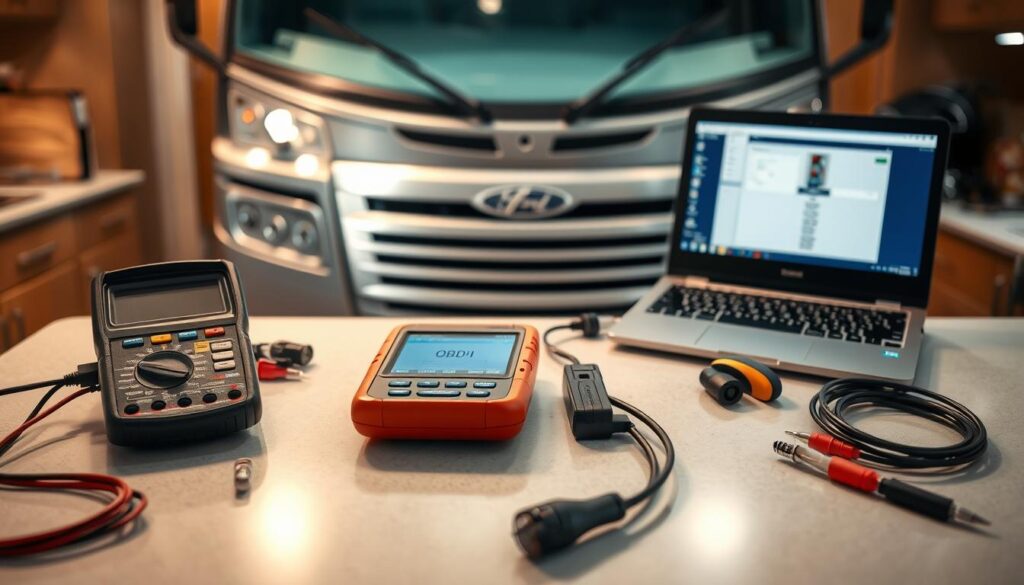
How to Use Remote Fault Diagnostic Tools for Class C Motorhome
Learning to use remote fault diagnostic tools is key for fixing Class C motorhomes. First, connect the tool and then analyze the codes it shows. This guide will walk you through connecting and understanding the data.
Step-by-Step Guide to Connecting the Tool
Start by finding the OBD-II port in your motorhome. It’s usually near the driver or under the dashboard. Here’s how to connect:
- Make sure the vehicle is turned on but not running.
- Plug the tool into the OBD-II port.
- Start the scan by following the tool’s instructions.
Interpreting Diagnostic Codes
After connecting, you need to understand the diagnostic codes. Each code points to a specific problem. Use guides or the tool’s help to learn about each code. Knowing common codes helps you make better repair choices.
Maintenance Tips for Class C Motorhomes
Keeping your Class C motorhome in top shape is key. Regular maintenance can avoid sudden breakdowns and expensive fixes. It’s important to check fluids, tire pressure, and battery health often.
Don’t forget to replace filters like oil and air filters regularly. This boosts your RV’s performance. Making a maintenance checklist helps keep everything on track. It ensures you don’t miss any critical tasks.
Setting up a schedule for checks is a smart move. Include tasks like tire rotation and brake inspection. These steps keep your RV safe and ready for your next trip.
Troubleshooting Common Problems with Remote Tools
Remote diagnostic tools have changed how RV owners fix problems. They offer step-by-step guides for common issues. Knowing how to use these tools helps solve problems faster.
When problems arise, tutorials on diagnostic codes are very helpful. They help RV owners understand the root of the issue. This knowledge lets them make better decisions.
Using both diagnostic tool suggestions and service manuals is key. It leads to a systematic way of fixing complex problems. This approach cuts down on downtime and improves the RV experience.
Advanced Features of Remote Diagnostic Tools
Remote diagnostic tools for Class C motorhomes have cool features that make vehicle care better. They help users check vehicle systems well and keep them running smoothly. Key parts like bi-directional testing and software integration are key to doing this well.
Bi-directional Testing Capabilities
Bi-directional testing lets users control vehicle functions for a detailed check. It helps mechanics and owners send commands and get feedback. This way, they can find problems faster than old methods.
Software Updates and Integrations
Keeping software up to date is vital for these tools. It lets users use the newest features and improvements. Also, working well with other vehicle systems is important. This makes fixing things quicker and cuts down on downtime for Class C motorhomes.
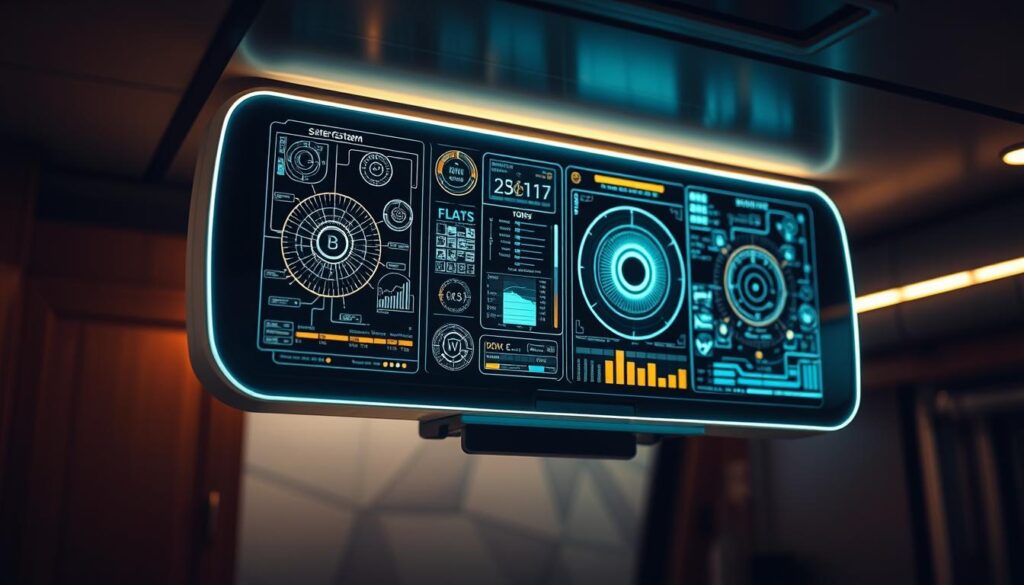
Case Studies: Success Stories Using Remote Diagnostic Tools
Case studies show how remote diagnostic tools work well in real life. They help find problems fast, saving time and money. This early detection stops small issues from becoming big repairs.
Real-Life Applications
Remote diagnostic tools help owners fix problems from a distance. They don’t need to know a lot about mechanics. For example, a family on a trip found an engine issue. They used their tool to find a small electrical problem and fixed it, continuing their journey safely.
Feedback from Class C Owners
Users love the quick and accurate info these tools give. Class C motorhome owners feel safer with these tools. They say using these apps makes them more confident on the road.
For more on how these apps help, check out telemetry apps for Class C motorhomes. The RV community is embracing these tech solutions more and more.
Conclusion
Remote diagnostic tools for RVs, especially Class C motorhomes, have changed how we maintain and fix our vehicles. They help find problems early, which is key to keeping your RV in top shape. This way, small issues don’t turn into big problems, and your RV lasts longer.
As RV technology gets better, using tools like these is more important than ever. They let RV owners keep their vehicles running smoothly, making trips more fun and worry-free. Adding these tools to your maintenance routine can lead to more exciting adventures on the road.
Knowing what’s going on with your Class C motorhome with these tools makes driving better and safer. It also gives you peace of mind when you’re exploring new places. Using this technology can make your travels unforgettable and keep your RV reliable for years.
FAQ
What are remote diagnostic tools for Class C motorhomes?
Remote diagnostic tools are devices and apps that connect to an RV’s computer systems. They help find and analyze problems in real-time. This way, users can spot issues early and avoid expensive repairs.
How do remote diagnostic tools improve RV maintenance?
These tools offer detailed fault analysis and real-time monitoring. They track the health of key systems like the engine and battery. This helps RV owners fix problems early, keeping their vehicles safe and running longer.
What common issues can remote diagnostic tools help identify in Class C motorhomes?
They can spot electrical failures, engine problems, and battery issues. Tools alert users to dim lights, overheating engines, or dead batteries. This lets owners fix problems quickly.
What features should I look for in a remote diagnostic tool?
Look for tools that work with many vehicles, are easy to use, and can test systems in both directions. Make sure the tool’s diagnostic protocol matches your RV’s systems, like OBD-II.
How do I set up a remote diagnostic tool in my Class C motorhome?
First, connect the tool to the OBD-II port. Then, install software on a computer or mobile device. Follow the manual to connect correctly and understand the diagnostic results.
Can I troubleshoot problems easily with remote diagnostic tools?
Yes, these tools make troubleshooting simple. They offer step-by-step guides and clear code explanations. Users can easily identify and fix issues.
What are bi-directional testing capabilities?
Bi-directional testing lets users control the vehicle’s functions through the tool. It’s a way to thoroughly check RV systems during diagnostics.
How often should I perform routine maintenance on my Class C motorhome?
Regular maintenance is key. Check fluid levels, tire pressure, and battery health often. This prevents unexpected breakdowns and keeps your RV reliable.
What advantages do advanced diagnostic tools offer?
Advanced tools get regular updates, work better, and integrate well with vehicles. They make maintenance faster and more efficient for RV owners.
What are some real-life benefits reported by Class C motorhome owners using diagnostic tools?
Owners save time and money by finding problems early. They praise the tools for reliable data and quick fixes. These benefits make RV travel safer and more reliable.


